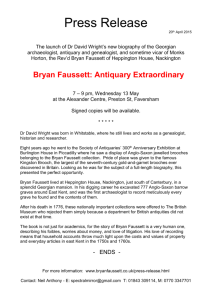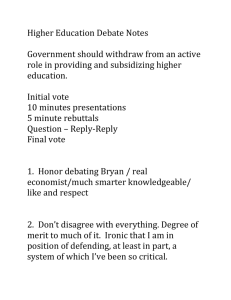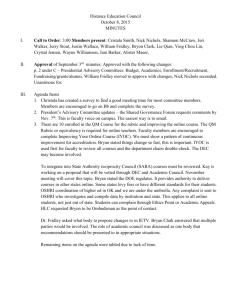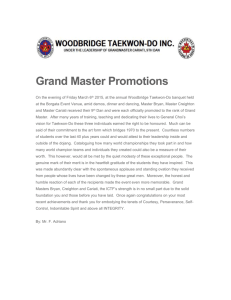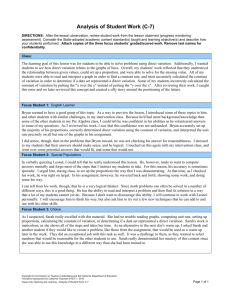IN THE COURT OF APPEALS OF THE STATE OF WASHINGTON
advertisement
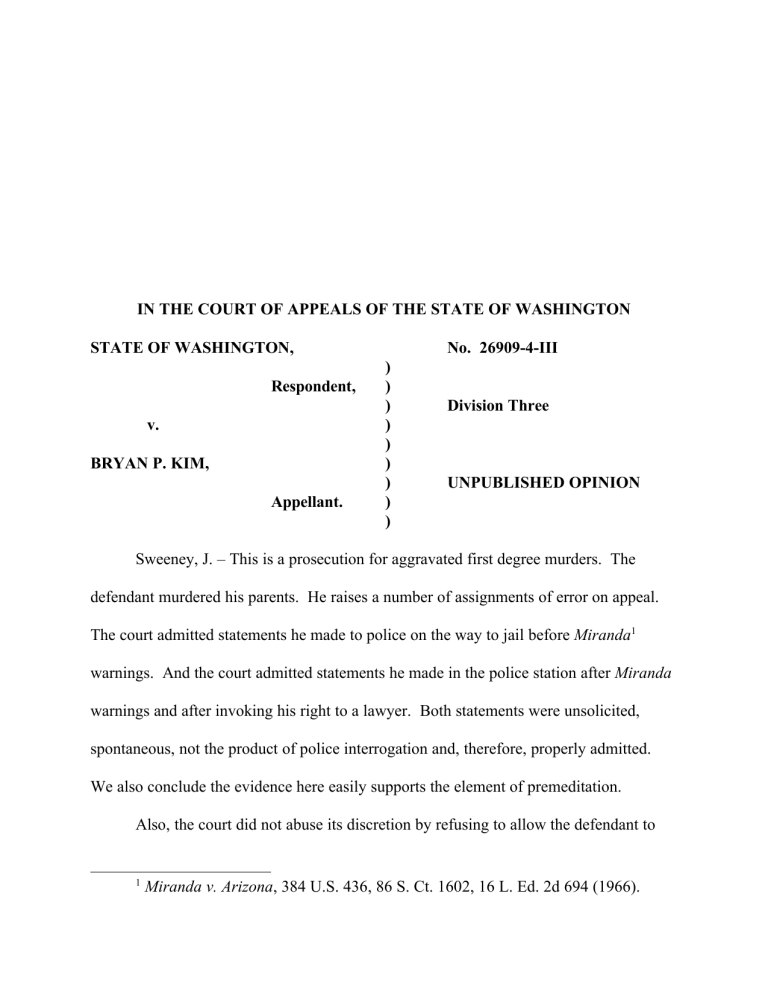
IN THE COURT OF APPEALS OF THE STATE OF WASHINGTON STATE OF WASHINGTON, Respondent, v. BRYAN P. KIM, Appellant. No. 26909-4-III ) ) ) ) ) ) ) ) ) Division Three UNPUBLISHED OPINION Sweeney, J. – This is a prosecution for aggravated first degree murders. The defendant murdered his parents. He raises a number of assignments of error on appeal. The court admitted statements he made to police on the way to jail before Miranda1 warnings. And the court admitted statements he made in the police station after Miranda warnings and after invoking his right to a lawyer. Both statements were unsolicited, spontaneous, not the product of police interrogation and, therefore, properly admitted. We also conclude the evidence here easily supports the element of premeditation. Also, the court did not abuse its discretion by refusing to allow the defendant to 1 Miranda v. Arizona, 384 U.S. 436, 86 S. Ct. 1602, 16 L. Ed. 2d 694 (1966). No. 26909-4-III State v. Kim recall a witness to impeach another witness on a collateral matter. And the court did not err by refusing to give an instruction on the voluntariness of the defendant’s statements. We therefore affirm the convictions for two counts of first degree murder with aggravating circumstances and a deadly weapon enhancement, one count of second degree possession of stolen property, and one count of second degree theft. FACTS Richard and Teresa Kim did not show up for work the morning of December 6, 2006. Their respective colleagues tried unsuccessfully to contact them and then alerted the police that something could be wrong. Two sheriff’s deputies went to the Kims’ home and found signs that the occupants had been assaulted. They found a cellular phone spattered with blood on the ground. They saw blood stains and a bucket in the entryway. They found no indications of forced entry. Deputy Mark Smoldt spoke to the Kims’ adult daughter, Jessica Kim. She told him what vehicles her mother, father, and 18-year-old brother, Bryan Kim,2 normally drove. Richard’s pickup and Teresa’s car were parked inside the garage. Bryan’s red hatchback car was not in the driveway or in the garage. The deputies forced entry into the house. They saw more blood in the entryway area along with a bucket, sponge, and 2 For the sake of clarity, we use Kim family members’ first names for the remainder of this opinion. We intend no disrespect. 2 No. 26909-4-III State v. Kim vacuum. They saw a lot more blood on the floor of the entryway closet and bloody garments hanging in the closet. A “Rambo-style” knife sat on the kitchen counter. In the upstairs master bedroom, a gun safe had been hacked apart; several guns and power tools were strewn across the floor. The deputies surveyed the perimeter of the home and property. They saw, through the shop window, a Bobcat front loader with blood-stained snow on the bucket. They noticed that Bobcat tracks marked paths to the shop, front porch, and garage. Gouge marks on the front porch and in the garage matched the teeth on the Bobcat bucket and the Bobcat’s chains. And the front porch appeared to be freshly washed. A deputy forced entry into the shop and found Richard and Teresa’s bodies inside the bucket. Their bodies had plastic bags over their heads and were tied to the bucket. Richard died from five stab wounds. Teresa was asphyxiated by ligatures (zip ties) around her neck; she had also suffered blunt trauma to her head and body. The medical examiner estimated the times of death as the evening or night of December 5, 2006. Detectives took Bryan from the high school he attended and brought him to the Spokane Public Safety Building. They informed Bryan of his rights. He declined to waive those rights. The detectives then arrested Bryan for the murder of his parents and executed a warrant to search him, his clothes, and his belongings. Teresa’s colleagues reported to the detectives that she had spoken to them about 3 No. 26909-4-III State v. Kim her concerns over her son. She asked one colleague if Bryan could live at the colleague’s house from January 2007 until he graduated high school. And Teresa left work early the Friday before her death because of concerns related to Bryan. That same night, Teresa and Richard did not make it to a holiday party they had planned to attend. Detectives found a billfold on the floor of the garage and a wallet containing Richard’s license in the kitchen. They found Richard and Teresa’s credit, debit, and membership cards in the kitchen and in the area of the basement used by Bryan. Two ATM withdrawals had been made from a bank account belonging to Richard, Teresa, and Jessica, totaling $1,003.50 on the morning of December 6. The same day, Bryan deposited $1,000 in cash into his checking and savings accounts. He also purchased a compass and a center console at NAPA Auto Parts and a video game at Fred Meyer’s before going to the high school that morning. The State charged Bryan with one count of premeditated first degree murder for the death of Richard, a second count of premeditated first degree murder for the death of Teresa, second degree possession of stolen property, and second degree theft other than a firearm. The State later amended the information to add aggravating factors to enhance any sentence. Bryan moved to suppress evidence of his statements. The court held a hearing and concluded that his statements were admissible. The case proceeded to trial before a jury. 4 No. 26909-4-III State v. Kim The jury found Bryan guilty of two counts of premeditated first degree murder, one count of second degree possession of stolen property, and one count of second degree theft. The jury returned four special verdicts. It found that Bryan was armed with a deadly weapon at the time he committed both counts of first degree murder. It also found an aggravating circumstance—more than one person was murdered as part of a common scheme or plan. The trial court sentenced Bryan to life in prison without the possibility of parole. DISCUSSION Admissibility of Statements The trial court exercises discretion to admit or exclude relevant evidence. State v. Swan, 114 Wn.2d 613, 658, 790 P.2d 610 (1990). We review that exercise of discretion for abuse of discretion. State v. Thomas, 150 Wn.2d 821, 869, 83 P.3d 970 (2004). When a trial court concludes that a confession was made voluntarily, we will not disturb that determination if there is “substantial evidence in the record from which the trial court could have found the confession was voluntary by a preponderance of the evidence.” State v. Aten, 130 Wn.2d 640, 664, 927 P.2d 210 (1996). Bryan contends that the trial court should have excluded two separate series of statements because each was impermissibly solicited by police while he was in custody. The State responds that both statements were unsolicited and, therefore, the court 5 No. 26909-4-III State v. Kim properly admitted them. Bryan made his first statement while being transported by detectives to the Public Safety Building. He told the two detectives that he had been arrested numerous times and had “gotten off” each time. Report of Proceedings (RP) at 511. He made other statements at the Public Safety Building after detectives told him that he was under arrest for the murder of his parents and that they would execute a search warrant on him. He said, “‘Go on with what you’re going to do. Book me. I’m going to cry myself to sleep later. Let’s get this going.’” RP at 512. Bryan’s first statement, regarding avoiding culpability on previous charges, was made before the detectives informed him of his Fifth Amendment rights. Bryan does not dispute that he made the statement; he asserts only that, in addition, he stated that he had avoided culpability by invoking his right to an attorney. Statements in response to custodial interrogation require a knowing, voluntary, and intelligent waiver by the suspect of the constitutional rights set out in Miranda warnings. But the State’s obligation to warn is not triggered unless and until there is both custody and interrogation. Miranda v. Arizona, 384 U.S. 436, 445, 86 S. Ct. 1602, 16 L. Ed. 2d 694 (1966). Voluntary statements made by the defendant, either wholly unsolicited or in response to questions not likely to solicit incriminating information, are admissible in the absence of Miranda warnings. State v. Eldred, 76 Wn.2d 443, 448, 457 P.2d 540 (1969). 6 No. 26909-4-III State v. Kim Here, Bryan made his first statements, about previous arrests and the lack of consequences following those arrests, spontaneously. The detectives had not asked him anything. He volunteered several statements while detectives transported him. He also commented about computer games and sports he played. Bryan testified at the suppression hearing that the statements were “small talk.” RP at 30. The court’s findings support its conclusion that the statements were voluntary. Clerk’s Papers at 201-04. Bryan also made a statement after he was searched, booked, and read his Miranda warnings. He told police that he would cry himself to sleep. But his statements to the detectives were again spontaneous and unsolicited. “[S]ince the police surely cannot be held accountable for the unforeseeable results of their words or actions, the definition of interrogation can extend only to words or actions on the part of police officers that they should have known were reasonably likely to elicit an incriminating response.” Rhode Island v. Innis, 446 U.S. 291, 301-02, 100 S. Ct. 1682, 64 L. Ed. 2d 297 (1980) (emphasis omitted). Bryan made his statements immediately after the detective explained the arrest and search warrant procedure. And the detective’s follow-up question, asking what Bryan meant by “‘Let’s get this going,’” did not render the interaction coercive, as Bryan’s counsel suggests. See RP at 22. Brief, neutral, non-accusatory inquiries do not infringe on the defendant’s privilege against self-incrimination. State v. Lister, 2 Wn. App. 737, 741, 469 P.2d 597 (1970). The trial court properly admitted Bryan’s voluntary 7 No. 26909-4-III State v. Kim statements. Admission of Witness’s Earlier Statement “Determinations regarding the scope of cross-examination are within the trial court’s discretion and will not be overturned on appeal absent an abuse of discretion.” State v. Dixon, 159 Wn.2d 65, 75, 147 P.3d 991 (2006). And, in general, “[t]he determination of whether testimony is admissible rests within the sound discretion of the trial court.” State v. Picard, 90 Wn. App. 890, 899, 954 P.2d 336 (1998). Bryan asked to recall the State’s witness, Detective Sherar, before the State rested. He wanted the detective to relate that John Hook, the principal of Bryan’s high school, told the detective in an interview on the day Bryan was arrested that Bryan had recently become more isolated from his peers. The court refused Bryan’s request to recall Detective Sherar. The court concluded that any inquiry was purely for impeachment of Mr. Hook’s testimony. Extrinsic evidence is generally not admissible to impeach a witness or defendant on collateral matters. State v. Dickenson, 48 Wn. App. 457, 468, 740 P.2d 312 (1987). To determine whether a fact is collateral, we ask, “Could the fact upon which error is based have been brought into evidence for a purpose independent of the contradiction?” Id.; accord State v. Descoteaux, 94 Wn.2d 31, 37-38, 614 P.2d 179 (1980) (collateral if the evidence is inadmissible for any purpose independent of the contradiction), overruled 8 No. 26909-4-III State v. Kim on other grounds by State v. Danforth, 97 Wn.2d 255, 643 P.2d 882 (1982). The impeachment must be on something of consequence to the case. State v. Allen S., 98 Wn. App. 452, 459-60, 989 P.2d 1222 (1999). Mr. Hook told Detective Sherar that Bryan had recently become more of a “loner.” RP at 607. Bryan’s essential argument for returning Detective Sherar to the witness stand was that an observation of Bryan’s social isolation tended to support his expert Dr. Michael Arambula’s diagnosis of manic depression disorder. First, the defense did not argue at trial nor does it argue here on appeal that Mr. Hook’s credibility was at issue. Moreover, since the defense would have been offering Mr. Hook’s prior statement (through Detective Sherar’s testimony) to prove the truth of the matter asserted, the statement would have been hearsay. See ER 801(c). Bryan did not establish how his being a loner made any fact of consequence to the determination of the charges at trial more or less probable. Therefore, Mr. Hook’s prior statement addressed a collateral matter. Dickenson, 48 Wn. App. at 468. The trial court did not abuse its discretion by declining to allow the defense to recall Detective Sherar to the witness stand. Instruction—Out-of-Court Statements We review this challenge to jury instructions de novo. State v. Pirtle, 127 Wn.2d 628, 656, 904 P.2d 245 (1995). “Jury instructions are sufficient if they are supported by 9 No. 26909-4-III State v. Kim substantial evidence, allow the parties to argue their theories of the case, and when read as a whole properly inform the jury of the applicable law.” State v. Clausing, 147 Wn.2d 620, 626, 56 P.3d 550 (2002). WPIC3 6.41 instructs jurors that they “may give such weight and credibility to any alleged out-of-court statements of the defendant as [they] see fit, taking into consideration the surrounding circumstances.” State v. Smith provides that a defendant is entitled to a WPIC 6.41 instruction when he raises the issue of the voluntariness of the statements after the court rules against the defendant’s earlier CrR 3.5 motion to exclude the statements. 36 Wn. App. 133, 141, 672 P.2d 759 (1983). A defendant’s right to a WPIC 6.41 instruction is procedural and not constitutionally mandated. State v. Taplin, 66 Wn.2d 687, 691, 404 P.2d 469 (1965). Bryan maintains that he was entitled to a WPIC 6.41 instruction. The State responds that Bryan did not challenge the voluntariness of the statements that the court admitted in the pretrial CrR 3.5 hearing. The record supports the State’s view. Bryan testified during the suppression hearing. He said he made his statements regarding “getting off” on prior arrests spontaneously and freely; he did not make those prearrest statements in response to any questions. RP at 31. Bryan complained only that 3 11 Washington Practice: Washington Pattern Jury Instructions: Criminal 6.41, at 196 (3d ed. 2008) (WPIC). 10 No. 26909-4-III State v. Kim the detective had truncated his statement. The detective repeated only that Bryan claimed he had been arrested previously and had escaped culpability on those charges; Bryan added that he told the detectives that he had been able to evade earlier charges because he had requested a lawyer. RP at 30-31. Bryan did not challenge the voluntariness of his statements to law enforcement. He was not, then, entitled to an instruction on the voluntariness of his statements. Smith, 36 Wn. App. at 141. The court did not err in declining to give such an instruction. Sufficiency of the Evidence—Premeditation Finally, Bryan contends that the evidence is insufficient to support the premeditation required for aggravated first degree murder. We view the evidence in the light most favorable to the State and ask whether any rational fact finder could have found the elements of the crime beyond a reasonable doubt. State v. Gentry, 125 Wn.2d 570, 596-97, 888 P.2d 1105 (1995). And the appellant who asserts that insufficient evidence supports his convictions “admits the truth of the State’s evidence and all inferences that can reasonably be drawn from that evidence.” Id. at 597. Aggravated first degree murder requires a showing that the defendant “[w]ith a premeditated intent to cause the death of another person, . . . causes the death of such person or of a third person” and a finding of one or more aggravating circumstances. RCW 9A.32.030(1)(a); RCW 10.95.020. 11 No. 26909-4-III State v. Kim Premeditation is “‘the deliberate formation of and reflection upon the intent to take a human life’ and involves ‘thinking beforehand, deliberation, reflection, weighing or reasoning for a period of time, however short.’” State v. Allen, 159 Wn.2d 1, 7-8, 147 P.3d 581 (2006) (internal quotations marks omitted) (quoting State v. Finch, 137 Wn.2d 792, 831, 975 P.2d 967 (1999)). Premeditation may be shown by circumstantial evidence if the jury’s inferences are reasonable and substantial evidence supports the jury’s verdict. Pirtle, 127 Wn.2d at 643. “To infer premeditation the Washington courts have looked for evidence relating to four factors: motive, the planned procurement of a weapon, stealth, and the method of killing.” Jones v. Wood, 207 F.3d 557, 564 (9th Cir. 2000). Here, the evidence showed that Bryan reacted angrily to his parents’ requirement that he follow certain family rules, pay rent and the copayment on his medications after he turned 18, and their demand, shortly before their deaths, that he move out of their house by January 2007. Police found a recent truancy letter and a written agreement between Bryan and his mother setting out his parents’ expectations of him on school work and attendance. Bryan’s cellular phone’s voicemail message had been changed by the day after the murders to a message from Richard indicating it was no longer Bryan’s phone. The gun safe in the Kims’ master bedroom contained Richard’s gun collection and was also where Richard and Teresa stored Bryan’s confiscated cell phone. The safe had been hacked apart. 12 No. 26909-4-III State v. Kim The State did not determine which knife Bryan used to kill his father. But a reasonable inference was that Bryan obtained the knife in a room other than the entryway. See id. Finally, the evidence supports an inference that Bryan killed his father by stabbing him five times in the chest and neck right after his father returned home from work. Richard’s body displayed defensive wounds. The majority of the blood spatter and staining was in the entryway coat closet. Other evidence indicated that someone made an effort to clean up the entryway and surrounding area, including: a vacuum cleaner that contained blood, wipe marks on the wall, a bucket in the entryway, a bloody sponge in the kitchen sink, and clothes with remnants of blood in the clothes dryer. And Richard’s coworker testified that he last saw Richard at approximately 5:00 p.m. on December 5, 2006. The medical examiner testified that Richard died some time that same evening. This evidence of motive applies equally to the murder of Teresa. The evidence showed that Teresa was also killed as she arrived home, likely a couple of hours after Richard. Bryan’s sister last talked to their mother by cellular phone at approximately 7:00 p.m. on December 5; Teresa was driving home from a teachers’ conference. The medical examiner testified that Teresa died that same evening. Teresa’s body was in her coat when police found her. Blood spatter on Teresa’s car and around the garage suggests that she was killed next to her car. She suffered internal injuries and several 13 No. 26909-4-III State v. Kim lacerations that resulted from blunt force trauma. Teresa died from asphyxiation caused by two zip ties tightened neatly around her neck. She also showed injuries that suggested she tried to defend herself prior to death. The medical examiner theorized that she may not have been conscious or capable of movement by the time the ligatures were applied. The showing of premeditation here was ample. 14 No. 26909-4-III State v. Kim We affirm the convictions. A majority of the panel has determined that this opinion will not be printed in the Washington Appellate Reports but it will be filed for public record pursuant to RCW 2.06.040. _______________________________ Sweeney, J. WE CONCUR: ________________________________ Schultheis, C.J. ________________________________ Brown, J. 15

